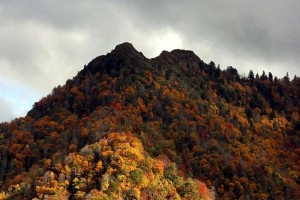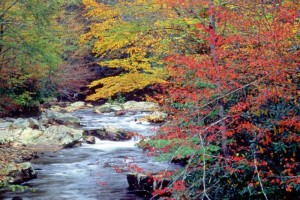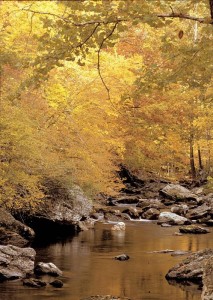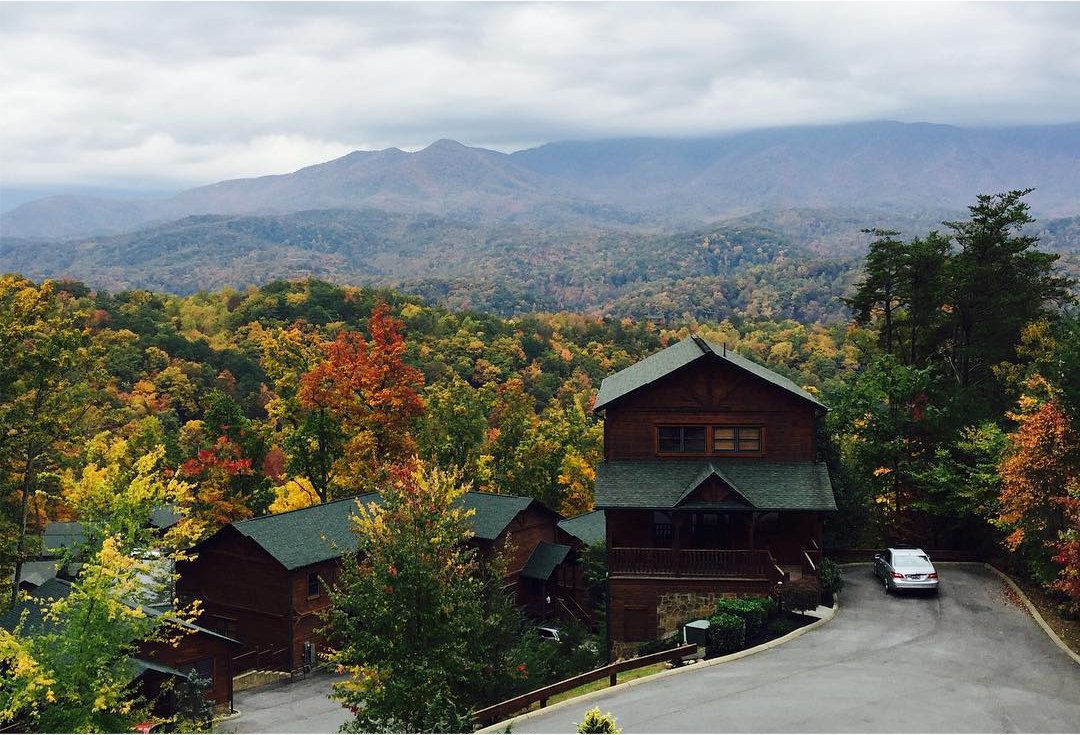Autumn leaf color changes in Great Smoky Mountains National Park is for many people the event of the year. The rolling mountain landscape forested with more than 100 varieties of trees provides a display of changing colors that lasts for almost 7 weeks. (For tips on where to go to view the colors, see our guide to Where to See the Fall Colors in the Smoky Mountains.)


Mid-September
The leaves begin to turn on the mountain tops and higher elevations around 6,000 feet as early as mid-September. The latter half of this month is a good time to be up in the mountains, hiking and driving to the scenic overlooks that provide good mountain panoramas.
Scenic drives in late September include Newfound Gap Road and Clingmans Dome. Higher elevation hikes good for this time include Andrews Bald and Mt. LeConte.
Early October

In the first part of October, the mountain tops have passed their peak but still have color, while the middle elevations above 4,000 feet come alive with leaf changes. By mid-October, the large swath of elevations between 3,000 and 5,000 feet will fill to their peak with colors. At this time the more accessible and moderate hikes can yield enormous rewards in scenery.
During the first half of October, scenic drives include Clingmans Dome Road, Foothills Parkway and Blue Ridge Parkway. This time presents the largest and most spectacular vista of colors as landscape and photo memories. Further down towards Gatlinburg and Cades Cove elevations, everything is still mostly green.
As the color moves gradually down the slopes to the lower elevations, the earlier yellows and more sparse reds give way to richer colors in greater profusion and variety, with many reds and golds appearing.
Late October
During the last half of October the peak color usually occurs in the lower elevations. When the lower elevations hit their peak there is also the feel of being surrounded by color everywhere you turn. This is a great time to be in Gatlinburg and driving along Little River Road towards Cades Cove. Hiking the trails from Cades Cove is one of the best ways to enjoy this color – the one to Abrams Falls is very popular.
A great scenic drive is Roaring Fork Motor Nature Trail, a one-way loop road that starts right in Gatlinburg. There are many walks and overlooks, with gorgeous waterfalls, all relatively accessible, some even visible from the car.
For many people, the last half of October is the peak time to visit the area. The weather affects the times of color peaks, but usually a lot of color will last into early November regardless.
Cold weather and rain both enhance the fall colors – the cold hastens the leaves turning, and the colors appear more vivid in rain. The only weather upset that people wish against is strong winds that can blow leaves off the trees.
What to Do When
The scenic opportunities are vast in the area. See our guide to Scenic Driving in Great Smoky Mountains National Park, and also our guide to Hiking in Great Smoky Mountains National Park. And for some sure-fire great destinations, here are some top ones situated all along the same road:
- Drive to Newfound Gap Overlook. US 441 through the Park is a spectacular scenic roadway and crosses the border from Tennessee into North Carolina here at the highest point of Newfound Gap Road. This point 15.5 miles from Sugarlands Visitor Center along the scenic route affords unsurpassed views of both states as far as the eye can see.
- Drive to Clingmans Dome. This is the highest point in the Park. Depending on visibility, 7 states can be seen from this observation point. Turn off Newfound Gap Road 0.1 mile south of Newfound Gap and follow the 7-mile-long Clingmans Dome Road to the large parking area at the end. When you get to the large parking lot, it’s a half-mile walk along the path to get to the observation tower. Check out our Clingmans Dome page for more information.
- Hike to Inspiration Point on Alum Cave Trail. This is actually the first stop on the itinerary, 10.5 miles south on the journey. Consider making the hike if you feel comfortable with your clothing, footwear and physical ability.The hike is 1.8 miles in EACH direction, there and back. It’s called a moderate hike, a fairly gentle climb. It’s very interesting all the way, through a rich old-growth forest with great views of the surrounding mountains.
- Carlos Campbell Overlook. If you’re short on time, you can bail out early on this trip just 2-3 miles along Newfound Gap Road. The Campbell Overlook has one of the best vistas in the Park, and perhaps the very best view for the minimal effort involved of Mt. LeConte. This place is worth a stop in its own right whenever you have time.
Crowds and traffic are the burden of being popular. To avoid these, try some of the less well known but equally beautiful places to drive and hike. The park rangers have this figured out for you also, see their Off the Beaten Path page. The Cosby end of the park is less visited and more tranquil. Parson Branch Road is well worth exploring, with the quiet feel of old forest.
And finally, when you’re in the area, there are some fun ways to see the fall colors both inside and outside the national park: see our guide to Where to See the Fall Colors in the Smoky Mountains.

Photo by Kahli Reynolds
TIP: Also see our Insider’s Visual Guide to the National Park – and remember that whatever part of the park interests you the most, we have vacation cabins all over the area: see our Gatlinburg cabin rentals, Pigeon Forge cabins, and Wears Valley cabins.





